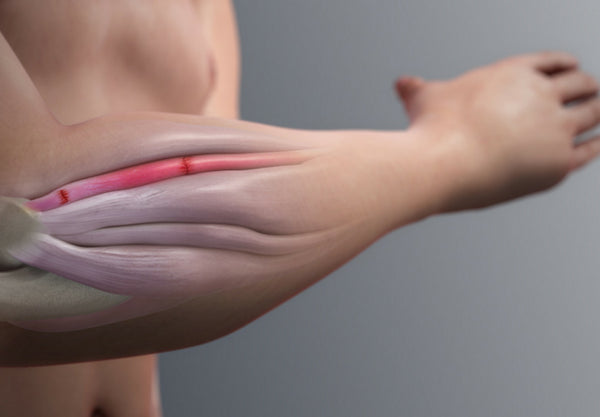Your Cart is Empty

If you are experiencing pain on the side of your elbow and are having difficulty lifting and gripping things, you may have tennis elbow. Tennis elbow, also known as lateral epicondylitis, is a condition that causes pain and inflammation in your elbow. This pain can limit your ability to perform normal, everyday tasks.
Tennis elbow is caused by inflammation in the common extensor tendon, a group of muscles located on the side of your elbow.
Anatomy of the Elbow
Your elbow is formed by the joint between your upper arm (the humerus) and the articulation of your radius and ulna of your forearm. There are many ligamentous and muscular attachments in your elbow that help move your elbow, forearm, and wrist.
The muscle group called the common extensor tendon is located on the outer part of your elbow and is responsible for extending your wrist. When your elbow is subjected to repetitive strain or overuse, this tendon can become inflamed, causing tennis elbow.
Treatments for Tennis Elbow
Various treatments for tennis elbow include, but are not limited to:
If you suspect you have tennis elbow, visit your doctor to get an accurate diagnosis and to start treating your problem right away.
 |
 |
|
ICEWRAPS 4X10 REUSABLE MULTIPURPOSE HOT/COLD GEL PACK, 2 PACK
|
ICEWRAPS SINGLE USE 4X7 INSTANT COLD PACKS, CASE OF 50
|
Using Ice for Tennis Elbow
During the initial phases of treating tennis elbow, you should apply ice to your arm and elbow to help control inflammation. The hallmarks of inflammation include pain, increased tissue temperature, and swelling of tissues.
The best way to manage inflammation that occurs with tennis elbow is to use the R.I.C.E. protocol. R.I.C.E. stands for rest, ice, compression, and elevation. Ice works to combat inflammation by decreasing circulation around your injured muscles and tendons. This helps to limit swelling and to decrease pain in your elbow.
Specially designed ice wraps are perfect to help provide your elbow with therapeutic cooling, compression and support during the initial treatment phase for tennis elbow. It may be a good idea to find an ice wrap that is made exclusively for elbows; this ensures that the ice and compression follow the contour of your elbow and provide maximal comfort and cooling.
Using Heat for Tennis Elbow
Once the initial inflammatory response is under control (usually 2-3 days after onset of pain), it may be time to start using heat for your tennis elbow. Heat can help by increasing blood flow to the injured tissues, decreasing muscular spasm, and improving mobility of the muscles around your elbow.
Heat is also a good idea to use just prior to stretching the muscles and tendons around your elbow and wrist. This helps to improve the overall extensibility of your muscles so you can get a more effective stretch.
Again, since elbows have specific contours and varied anatomy, it is best to use a hot pack that is specifically designed to fit your elbow. This ensures safe application and proper distribution of the heat around your elbow.
Some doctors recommend switching between using ice and heat for tennis elbow. Simply place ice on your elbow for 15 to 20 minutes, then switch to using heat for 15 to 20 minutes. After using the heat, let your elbow rest for 20 minutes, then repeat the cycle.
Exercise for Tennis Elbow
The symptoms of tennis elbow typically respond well to gentle exercises. It is best to visit a qualified healthcare professional, like a physical therapist, to learn the best exercises for you to do for your specific condition.
Wrist and elbow stretches are effective to help improve the mobility and flexibility around your forearm and hand. Wrist strengthening exercises can help improve your muscles' ability to tolerate loads and stresses that you may encounter during your daily activities. Remember, with all exercises you should start slow and gradually progress; any increase in pain in your elbow may be an indication that you are re-injuring the common extensor tendons and making your tennis elbow worse.
Other Options for Tennis Elbow
Bracing may be another option to treat your tennis elbow. Small compression braces help to gently relocate your common extensor tendon and help it gain a mechanical advantage while it is working. This can limit the amount of stress that is placed through your elbow and tendon.
If your tennis elbow symptoms persist, you may wish to visit an orthopedic surgeon to assess your condition. Sometimes, cortisone injections into your elbow may be necessary to control inflammation. As a last resort, surgery may be required to take stress off of your elbow's tendons and relieve your pain from tennis elbow. Using ice immediately after surgery for your elbow can help control the post-operative swelling and pain that may occur. Of course, consult your doctor to learn what you should do for your specific condition.
Bottom Line
Tennis elbow is a common condition that can easily be treated using ice, heat, and gentle stretching and strengthening exercises. By doing the right treatments correctly and early on, you can be sure to quickly and effectively manage your tennis elbow symptoms.
Comments will be approved before showing up.